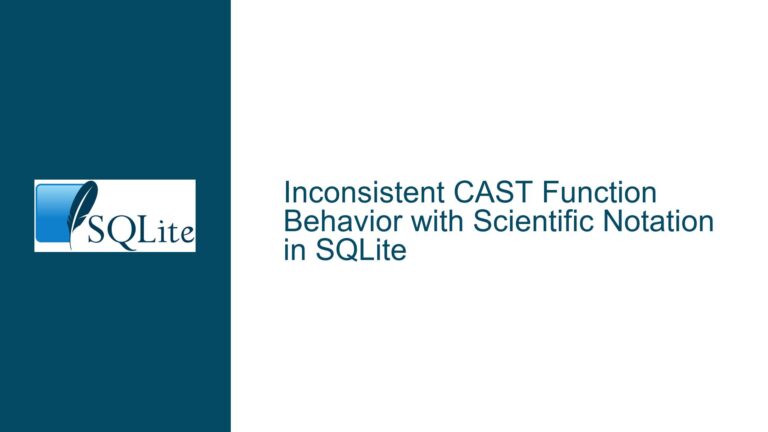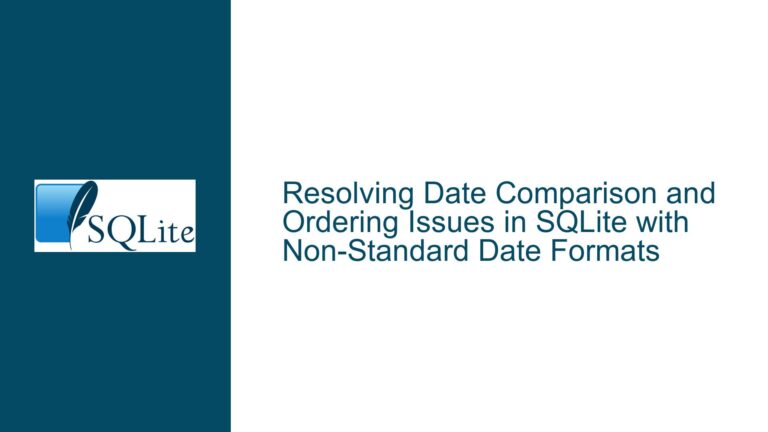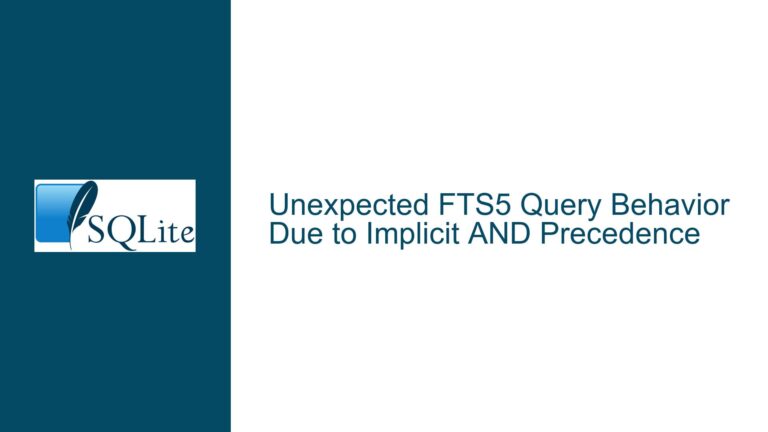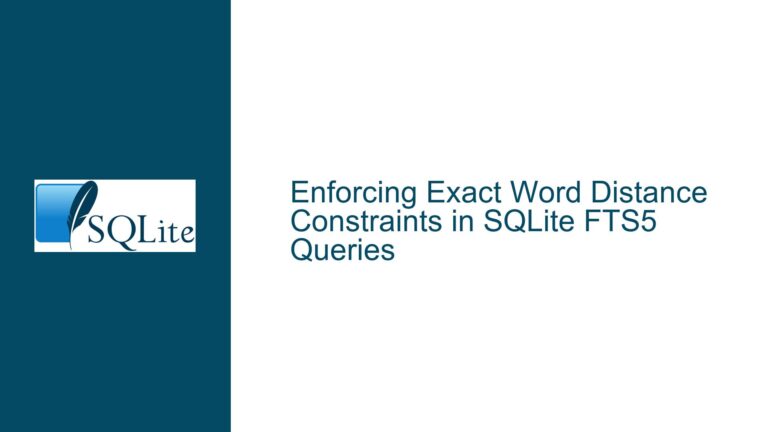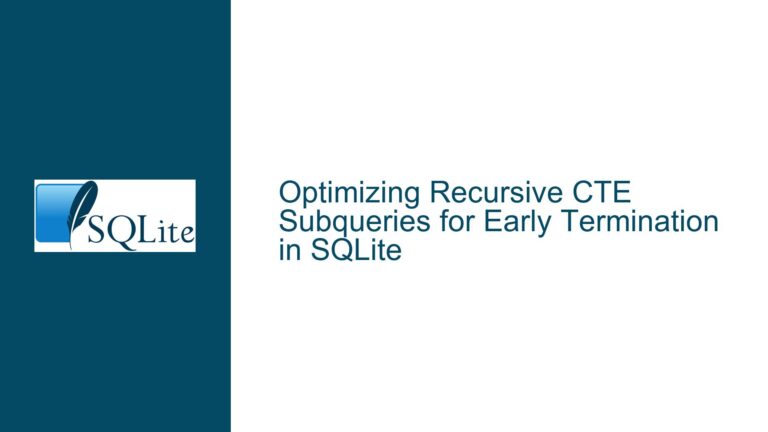SQLite Integer Overflow and Precision Loss in WHERE vs SELECT Clauses
Integer Overflow and Precision Loss in SQLite Comparisons
The core issue revolves around the inconsistent behavior of SQLite when performing comparisons involving large integers in the WHERE clause versus the SELECT clause. Specifically, the problem arises when comparing a column value with an expression that results in an integer overflow or precision loss due to floating-point conversion. This inconsistency is particularly evident when the column in question is an INTEGER PRIMARY KEY, as SQLite treats such columns as aliases for the ROWID, which has special handling during query execution.
The example provided involves a table v0 with a single column v1 defined as an INTEGER PRIMARY KEY. The value 9223372036854775807 (the maximum 64-bit signed integer) is inserted into this column. The query then attempts to compare this value with (9223372036854775807 + 1), which results in an overflow. The behavior differs depending on whether the comparison is performed in the WHERE clause or the SELECT clause, and whether v1 is defined as a primary key.
In the WHERE clause, the comparison v1 >= (9223372036854775807 + 1) returns the row with v1 = 9223372036854775807, suggesting that the comparison evaluates to TRUE. However, in the SELECT clause, the same comparison v1 >= (9223372036854775807 + 1) returns 0, indicating FALSE. This discrepancy is due to the way SQLite handles type affinity, integer overflow, and floating-point conversions during query execution.
Floating-Point Conversion and RowID Lookup Precision Loss
The root cause of this inconsistency lies in SQLite’s type affinity system and its handling of ROWID lookups. When v1 is defined as an INTEGER PRIMARY KEY, it is treated as an alias for the ROWID. During a WHERE clause comparison involving a ROWID, SQLite attempts to convert the comparison value to an integer for efficient row lookup. However, the expression (9223372036854775807 + 1) results in an overflow, which SQLite handles by converting the result to a floating-point number (9223372036854775000.0). When this floating-point number is converted back to an integer for the ROWID lookup, precision is lost, resulting in the value 9223372036854774784.
The comparison 9223372036854775807 >= 9223372036854774784 evaluates to TRUE, causing the row to be included in the result set. However, in the SELECT clause, the comparison is performed directly without the intermediate conversion for row lookup. Here, the floating-point result 9223372036854775000.0 is used as-is, and the comparison 9223372036854775807 >= 9223372036854775000.0 evaluates to FALSE due to the lack of precision loss.
When v1 is not defined as a primary key, the behavior is consistent between the WHERE and SELECT clauses because SQLite does not perform the intermediate conversion for row lookup. In this case, the comparison v1 >= (9223372036854775807 + 1) evaluates to NULL in the WHERE clause and 0 in the SELECT clause, as the overflow results in an invalid comparison.
Mitigating Integer Overflow and Precision Loss in SQLite Queries
To address this issue, developers must be aware of SQLite’s handling of large integers, type affinity, and ROWID lookups. The following steps can help mitigate the risks of integer overflow and precision loss in SQLite queries:
Avoid Integer Overflow in Expressions: Ensure that arithmetic expressions involving large integers do not exceed the 64-bit signed integer range. For example, instead of writing
(9223372036854775807 + 1), use a literal value or a subquery that avoids overflow.Use Explicit Type Casting: When dealing with large integers, explicitly cast values to the appropriate type to prevent unintended floating-point conversions. For example, use
CAST(9223372036854775807 AS INTEGER)to ensure the value is treated as an integer.Leverage SQLite’s Type Affinity Rules: Understand how SQLite’s type affinity system affects comparisons and conversions. For instance, columns with
INTEGERaffinity will attempt to convert values to integers, which can lead to precision loss.Test Queries with Edge Cases: Always test queries with edge cases, such as the maximum and minimum values for the data types involved, to ensure consistent behavior across different clauses.
Consider Alternative Database Designs: If precision is critical, consider using a database system that supports arbitrary-precision arithmetic or a different schema design that avoids reliance on
ROWIDlookups.Monitor SQLite Updates: SQLite is actively maintained, and issues like this are often addressed in newer versions. For example, the fix referenced in the discussion (check-in
f9c6426de3b413ff) resolves this specific issue. Always keep SQLite up to date to benefit from such fixes.
By following these steps, developers can avoid the pitfalls of integer overflow and precision loss in SQLite queries, ensuring consistent and accurate results across different clauses and scenarios.
Detailed Analysis of SQLite’s Handling of Large Integers
To further understand the issue, let’s delve into SQLite’s internal handling of large integers and type conversions. SQLite uses a dynamic type system, where the type of a value is associated with the value itself rather than the column in which it is stored. However, columns have a type affinity that influences how values are stored and compared.
Type Affinity and Storage Classes
SQLite has five storage classes: NULL, INTEGER, REAL, TEXT, and BLOB. Each column in a table has a type affinity, which can be INTEGER, REAL, TEXT, BLOB, or NUMERIC. The type affinity determines how values are converted when inserted into the column.
For example, a column with INTEGER affinity will attempt to convert inserted values to integers. If the value cannot be converted to an integer without data loss, it is stored as a REAL or TEXT instead. This behavior is crucial in understanding the issue at hand.
Integer Overflow and Floating-Point Conversion
When an arithmetic operation results in an integer overflow, SQLite converts the result to a floating-point number. This conversion can lead to precision loss, as floating-point numbers have limited precision compared to integers. In the example, the expression (9223372036854775807 + 1) results in an overflow, and SQLite converts the result to 9223372036854775000.0.
RowID Lookup and Precision Loss
When a column is defined as an INTEGER PRIMARY KEY, it is treated as an alias for the ROWID. During a WHERE clause comparison involving a ROWID, SQLite attempts to convert the comparison value to an integer for efficient row lookup. This conversion can lead to further precision loss, as seen in the example where 9223372036854775000.0 is converted to 9223372036854774784.
Comparison in WHERE vs SELECT Clauses
The difference in behavior between the WHERE and SELECT clauses arises from the way SQLite handles comparisons in each context. In the WHERE clause, the comparison is used to filter rows, and SQLite may perform additional conversions to optimize the query. In the SELECT clause, the comparison is evaluated directly, without the intermediate conversions for row lookup.
Practical Implications for Query Design
Understanding these nuances is essential for designing robust queries in SQLite. Developers must be mindful of the potential for integer overflow and precision loss, especially when working with large integers and ROWID lookups. By carefully crafting queries and testing edge cases, developers can avoid unexpected behavior and ensure accurate results.
Conclusion
The issue of inconsistent comparison results in SQLite’s WHERE and SELECT clauses highlights the importance of understanding the database’s type system, type affinity, and handling of large integers. By being aware of these intricacies and following best practices, developers can mitigate the risks of integer overflow and precision loss, ensuring consistent and accurate query results.

